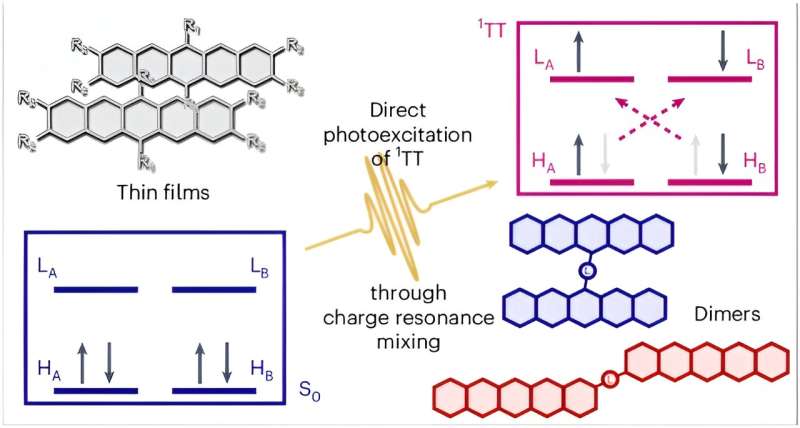This article has been reviewed according to Science X's editorial process and policies. Editors have highlighted the following attributes while ensuring the content's credibility:
fact-checked
peer-reviewed publication
trusted source
proofread
'Two-for-one' fission aims to improve solar cell efficiency

Singlet fission occurs when an organic molecule absorbs one photon of light, then splits that light's energy in two—a doubling effect that has the potential to improve the light-harvesting efficiency in solar cells, assuming the generated electrons can be properly harvested.
A Cornell-led team used ultrafast laser spectroscopy to scrutinize a key intermediate state during the fission process, called the triplet-pair state, and found that in certain molecules the intermediate can be directly generated by using a strikingly simple technique—in effect, singlet fission without the singlet.
"This kind of two-for-one deal is a very profound way to make solar cells much better, but ever since the '60s people thought you always have to start by exciting one electron, and then it relaxes to give you two," said Andrew Musser, assistant professor of chemistry and chemical biology in the College of Arts and Sciences, who led the team.
"We can see directly in our experimental data the signature that you don't need to start in the singlet, you can directly excite these two electrons."
The team's paper, "Coherent Photoexcitation of Entangled Triplet Pair States," was published on June 19 in Nature Chemistry. The paper's co-lead authors are postdoctoral researcher Juno Kim and doctoral student David Bain.
Musser's research group studies the interactions between light and matter in organic materials, with the goal of improving their properties. One such family of materials are pentacenes, hydrocarbon compounds that consist of five connected benzene rings.
Several years ago, a postdoctoral researcher in the group, Woojae Kim, who is now a professor at Yonsei University in Seoul, South Korea, noticed an unexplainable anomaly in one of their molecule samples. There was a weak spike in its absorption spectrum in a region where it should not be able to absorb a photon.
"This is the kind of small detail that usually you neglect, but I was lucky to have a meticulous scientist like Woojae on the job," Musser said. "He realized there were published papers where people had this feature, but they just completely overlooked it in other materials.
"It's in a suspicious region where we started to think this is related to the triplet-pair state that we're interested in, for singlet fission. We'd always thought about it as 'dark,' unable to absorb light. But maybe it's not so dark after all."
The researchers assembled different derivatives of pentacene and subjected them to various ultrafast laser spectroscopy techniques to see if they could establish a generalized principle for the anomaly, which they eventually attributed to the triplet-pair state.
"We had to design and build our own setup, effectively an ultrafast video camera, in order to make these measurements," Bain said. "To be able to see the very fast processes that happen when a photon is absorbed, I had to learn to generate optical pulses that are shorter than 10 femtoseconds. But then we could clearly detect when the triplet-pair state is directly generated and eventually benchmark this behavior in several different molecules."
Typically, when a photon gets absorbed in a molecule, a single electron becomes excited. However, when the triplet-pair state is directly generated, two electrons become excited simultaneously in the same way. By seeing which molecules produced the triplet-pair state and which didn't, the researchers were able to extract a few design rules that enable the phenomenon to occur.
The "magic" ingredient, they determined, is what's called the symmetric charge resonance state, a feature of quantum mechanics in which molecules that trade electrons begin to interact more strongly.
"This is a great example of material photophysical properties that go beyond our understanding from classical mechanics, basically the one-electron picture," Juno Kim said. "When we factor in the quantum mechanical probability from this magic ingredient, completely unexpected new behavior emerges."
Now, the researchers have the ability to engineer the effect of directly photo-exciting the intermediate triplet-pair from the ground state. The benefits extend beyond solar cells. Because the spin states of the electrons are entangled, singlet fission can potentially be used as a platform for quantum information science and quantum computing.
"What is cool about this study is that we've discovered a way, through molecular design, to circumvent the selection rules that limit what we can do in material photophysics," Musser said.
"And that lets us turn these older materials and well-known phenomena into something new for applications, because we don't always have to follow the rules. They become more like guidelines."
More information: Juno Kim et al, Coherent photoexcitation of entangled triplet pair states, Nature Chemistry (2024). DOI: 10.1038/s41557-024-01556-3
Journal information: Nature Chemistry
Provided by Cornell University





















